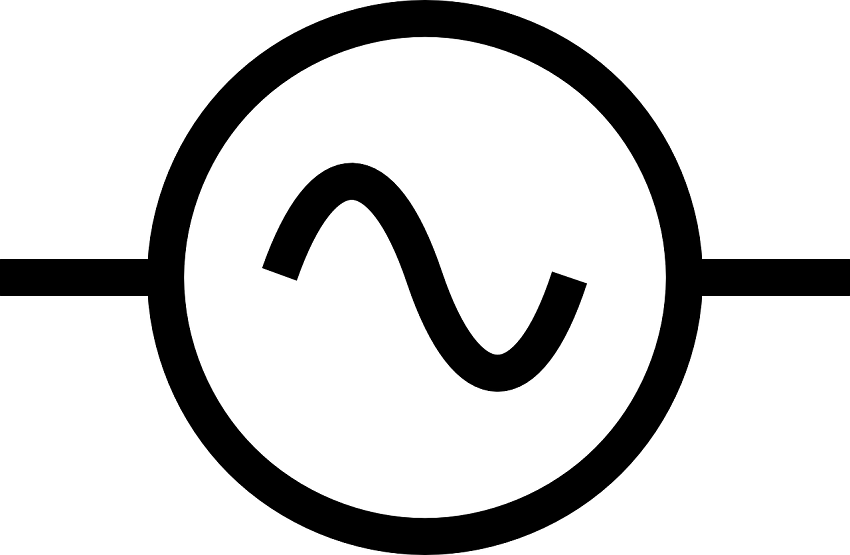Alternating current and direct current

|
| The sinusoidal curve that represents the positive and negative phases of AC current. |
Contents |
[edit] Introduction
An electric current is a flow of charge along a conductor, such as a copper wire. When it flows in one direction it is called direct current (DC). When it reverses direction periodically it is termed an alternating current (AC).
AC current is generally used to power homes and businesses, and is also present when audio and radio signals are carried on electrical wires. DC current is typical of batteries that power flashlights and other home appliances and is also used in some industrial applications.
Because AC current reverses direction periodically, it can be characterised by a sinusoidal waveform where the half periods above the x-axis represent the positive phase of the current and the half periods below the x-axis represent the negative phase.
AC current operates in the following way: it will start from a position of zero, build up to its maximum value (top of the positive peak on the sinusoidal curve), reverse to zero, continue to the maximum in the opposite direction (negative, below the x-axis) then reverse back to zero, upon which the cycle begins again. The number of these cycles performed per second is called the frequency and is measured in hertz (Hz).
Domestic and commercial power in the UK and other countries is typically of low frequency (50-60Hz). Far higher frequencies are encountered in other applications such as television (100,000,000 cycles/second (100 megahertz (or 100MHz) where 1MHz is one million cycles/second)). Even higher frequencies of several thousand megahertz are used in microwave and radar applications, while in mobile phones they may be in the order of around 1,000MHz (one thousand million hertz or 1 gigahertz (GHz).
Many electronic devices contain semi-conductors which require low-voltage DC. This means that such devices must convert high voltage AC to low voltage DC. This is usually achieved by the plug-in power plug that is supplied with the device.
[edit] Some advantages of AC over DC
AC current offers numerous benefits over DC. Typically, these include:
- AC can be relatively easily and economically stepped up or down with a transformer to suit the application. DC cannot be wired through a transformer.
- Because it can be stepped up (and down), AC can be increased to high voltage levels for transmission over large distances, then stepped down to safer levels for consumer use.
- High voltages can be generated in AC. This is more difficult with DC.
- Because of the high voltages that can be generated, AC can be transmitted over long distances.
- Long-range transmission results in relatively low energy losses resulting from resistance.
- AC is cheaper to generate than DC.
- AC can be easily converted to DC if required.
[edit] DC networks
The Energy Saving Trust estimated in 2007 that by 2020, 45% of the electricity consumption in a household would be entertainment, computers and gadgets and LED lighting, all of which are DC-powered. This, in combination with the emergance of DC generation from solar panels, and battery storage, have given rise to the concept of DC (rather than AC) networks.
For more information see: DC electricity networks.
[edit] Related articles on Designing Buildings Wiki
- DC electricity networks.
- Electricity supply.
- Energy consumption.
- Energy storage.
- Fossil fuel.
- Hydroelectricity.
- Micro-grids.
- Microgeneration.
- Oil - a global perspective.
- Power.
- PV inverter.
- Renewable energy.
- Single-phase v three-phase ac current systems.
- Solar photovoltaics.
- The future of UK power generation.
- Types of fuel.
- Watt.
Featured articles and news
The UK's Modern Industrial Strategy: A 10 year plan
Previous consultation criticism, current key elements and general support with some persisting reservations.
Building Safety Regulator reforms
New roles, new staff and a new fast track service pave the way for a single construction regulator.
Architectural Technologist CPDs and Communications
CIAT CPD… and how you can do it!
Cooling centres and cool spaces
Managing extreme heat in cities by directing the public to places for heat stress relief and water sources.
Winter gardens: A brief history and warm variations
Extending the season with glass in different forms and terms.
Restoring Great Yarmouth's Winter Gardens
Transforming one of the least sustainable constructions imaginable.
Construction Skills Mission Board launch sector drive
Newly formed government and industry collaboration set strategy for recruiting an additional 100,000 construction workers a year.
New Architects Code comes into effect in September 2025
ARB Architects Code of Conduct and Practice available with ongoing consultation regarding guidance.
Welsh Skills Body (Medr) launches ambitious plan
The new skills body brings together funding and regulation of tertiary education and research for the devolved nation.
Paul Gandy FCIOB announced as next CIOB President
Former Tilbury Douglas CEO takes helm.
UK Infrastructure: A 10 Year Strategy. In brief with reactions
With the National Infrastructure and Service Transformation Authority (NISTA).
Ebenezer Howard: inventor of the garden city. Book review.
The Grenfell Tower fire, eight years on
A time to pause and reflect as Dubai tower block fire reported just before anniversary.
Airtightness Topic Guide BSRIA TG 27/2025
Explaining the basics of airtightness, what it is, why it's important, when it's required and how it's carried out.
Construction contract awards hit lowest point of 2025
Plummeting for second consecutive month, intensifying concerns for housing and infrastructure goals.
Understanding Mental Health in the Built Environment 2025
Examining the state of mental health in construction, shedding light on levels of stress, anxiety and depression.





















